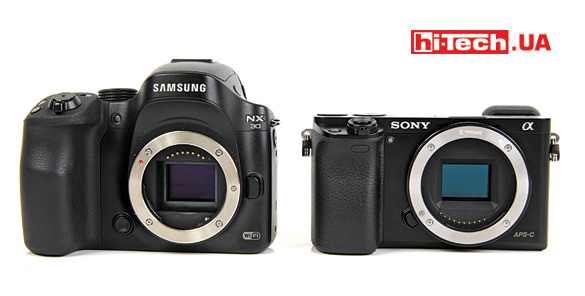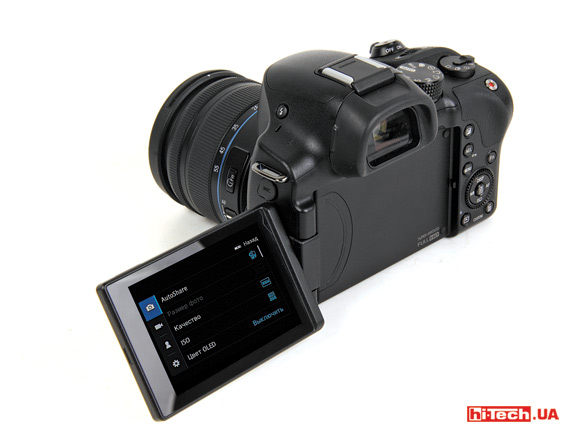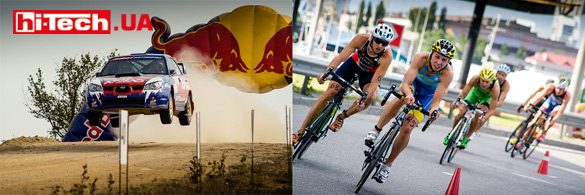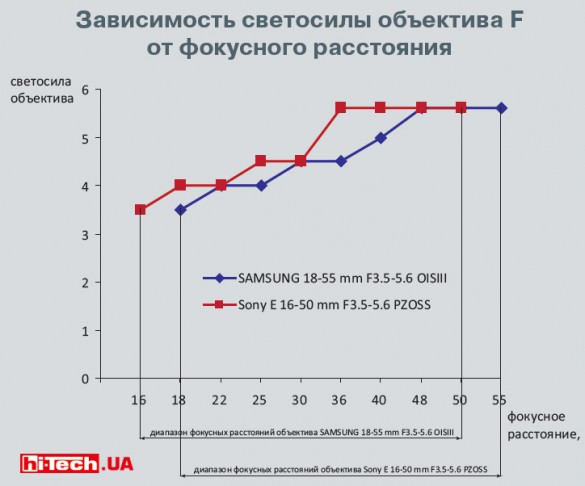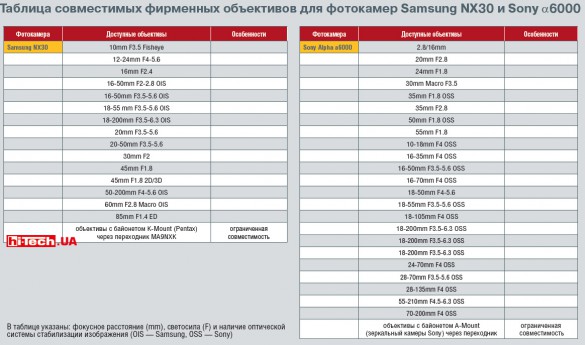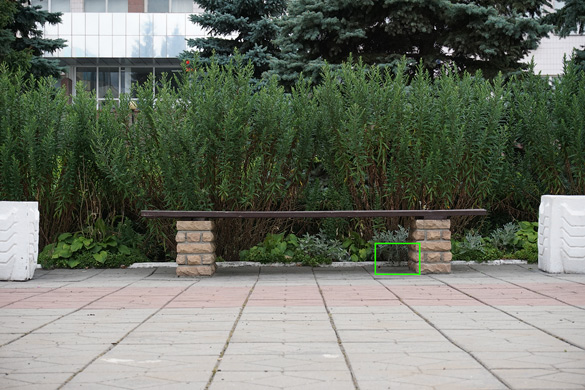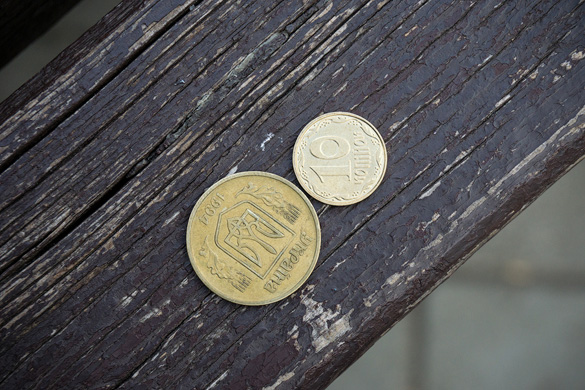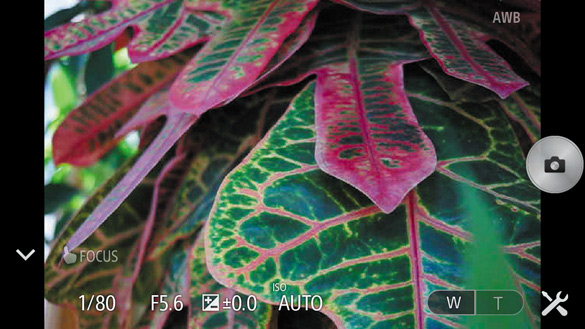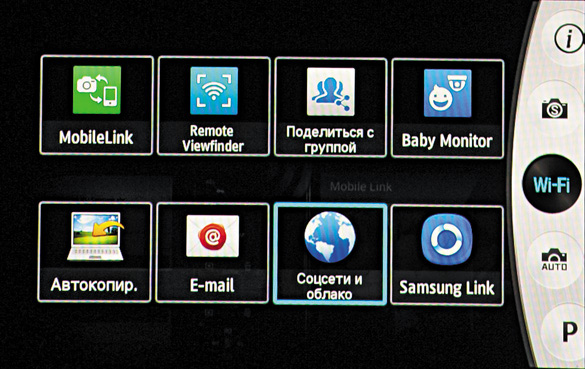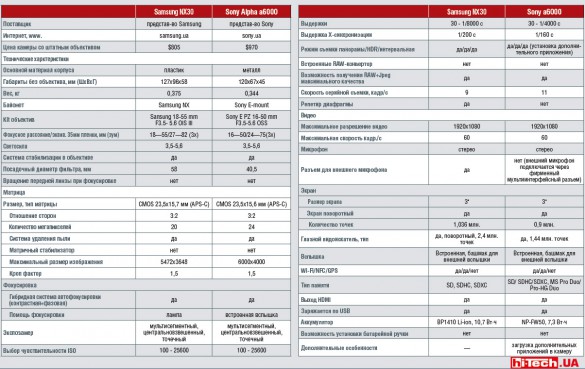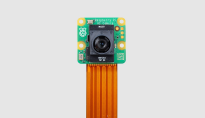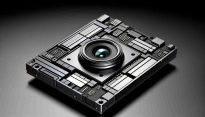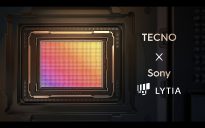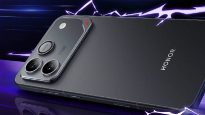We compare the cameras Samsung NX30 and Sony Alpha a6000. Who will win?
10.10.14With significant external differences, the Samsung NX 30 and Sony Alpha a6000 cameras can be called “classmates” in terms of class, cost and capabilities. Let’s compare…
The Samsung NX 30 and Sony Alpha a6000 cameras belong to the class of mirrorless cameras with interchangeable lenses. Such cameras are also called hybrid. Samsung and Sony can safely be called experienced manufacturers of this kind of cameras. Over the past few years, companies have released many models in different price categories.
I have always noted that an important characteristic for a camera is the size of the light-receiving matrix. The larger it is, the, other things being equal, you can count on higher image quality. The main lines of mirrorless cameras from Samsung and Sony, which include the Samsung NX 30 and Sony Alpha a6000 cameras under review, have relatively large APS-C size matrices (approximately 23.5 × 15.7 mm). For example: matrices of the same size are installed in entry-level and mid-level SLR cameras from Nikon, Canon, Sony, Pentax. Compared to mirrorless cameras, Fujifilm cameras are equipped with sensors of similar size. Panasonic and Olympus mirrorless cameras have smaller 4/3” matrices, and Nikon mirrorless matrices are even more compact – one-inch. To be fair, it should be noted that the largest matrices among mirrorless cameras are possessed by some exotic Leica models and relatively recently appeared Sony A7 (A7r, A7s) cameras. They are equipped with so-called full-frame matrices measuring 36×24 mm.
Among Samsung cameras, the NX30 can be called a true flagship. This is the most advanced model from the manufacturer (it was before the appearance of Samsung NX1 at the photokina 2014 exhibition). At the same time, the Sony a6000 is not Sony’s flagship. But at the moment it can be called the most advanced camera in the modern line of Sony mirrorless cameras with APS-C matrices. With complete kit lenses, the cost of the cameras is just under $1000.
Both models under consideration are capable of satisfying the needs of photo enthusiasts and advanced amateurs.
Dimensions, comfort
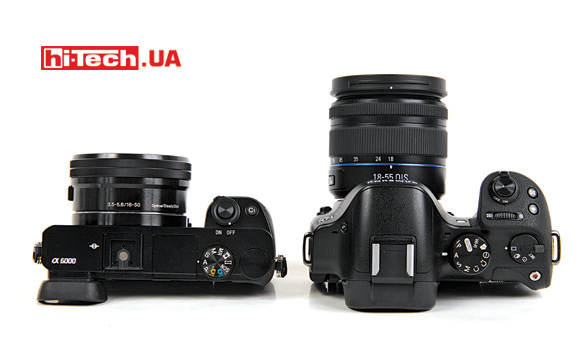
A large pocket for the Sony A6000 can still be found, but the Samsung NX30 (on the right) will probably only fit in a case or bag
The NX30 and a6000 differ significantly in size and design. The NX30 mimics the design of DSLR cameras, while the a6000 is designed in the style of classic rangefinder cameras. I note that this “pseudo-mirror” design is not typical of all Samsung mirrorless cameras. Many models, as a rule, also resemble rangefinders.
The NX30’s camera is noticeably larger, but is this a disadvantage? Yes, such a camera takes up more space during transportation and can hardly be carried in a pocket, but when shooting directly, the NX30 is more convenient to hold than the a6000. However, the a6000 cannot be called inconvenient. It’s just that in this parameter, in my opinion, it loses a little to the NX30.
There are no complaints about the build quality from the participants. Everything is done to a high standard. But in the hand the Sony Alpha a6000 feels more solid. All this is thanks to the use of metal, and not just plastic in the exterior. The standard lens on the a6000 also looks more attractive in appearance.
Screen, viewfinder
Today it is quite difficult to imagine a mirrorless camera without a rotating screen. The advantages of using such a solution are obvious. So it’s no surprise that the NX 30 and a6000 have rotating screens.
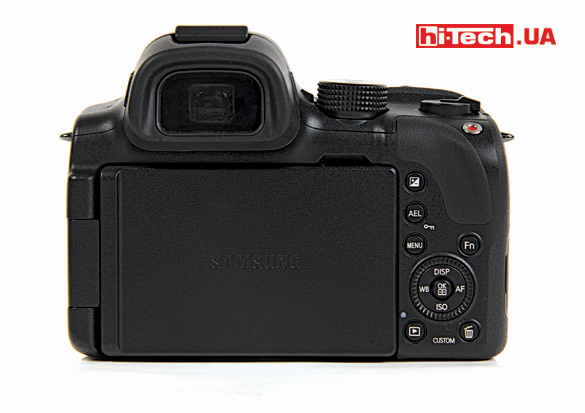
The design of the rotating screen of the Samsung NX30 is more advanced and convenient compared to the Sony A6000. The screen can be fully unfolded and protected during transport, and can also be used when taking self-portraits
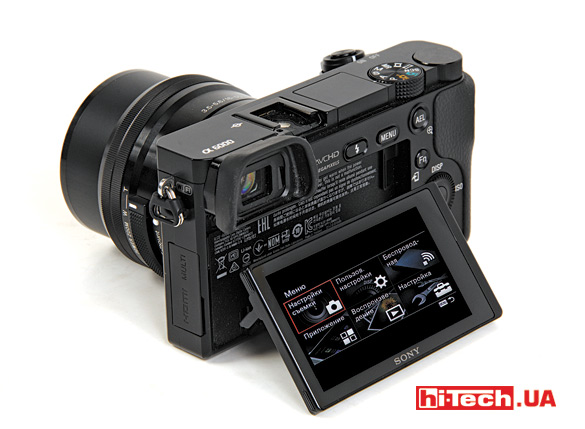
Sony Alpha a6000. Taking into account the fact that sometimes you have to enter Wi-Fi passwords and account information on the camera, touch input would be very useful, but it is not provided here
In practice, it turned out that the design of the rotating screens of the cameras in question is very different, with a clear advantage in favor of Samsung. If desired, the NX30 screen can be completely turned upside down and there is no fear that it will be scratched during transportation or wearing on a belt; it can be used when shooting self-portraits. The Sony Alpha a6000 display does not have such degrees of freedom and can only change the vertical angle within certain limits. By the way, a rotating screen design similar to the a6000 (in my opinion, not the most successful) is exactly what is used in most mirrorless cameras. This may be due to the difficulties of implementing an advanced rotary mechanism in compact housings.
The built-in eye viewfinder is rather a feature of advanced mirrorless cameras. It is usually not available for simple models or is offered as an additional plug-in accessory. The Samsung NX30 and Sony Alpha a6000 have built-in eye viewfinders. What can they be useful for?
For example, under the bright sun it is not so comfortable to view using the main screen, but, in my opinion, it is much more important that it is more convenient to view using the eye viewfinder when shooting with wiring and in general when shooting moving objects.

The Samsung NX30 not only has a rotatable main screen, but also an eye viewfinder. I have never seen such a solution before
The main screen sizes of the NX30 and a6000 are equal. As for the screen resolutions and eye viewfinder, they differ between models, but I would not say that there is any fundamental difference. In terms of detail, the picture on the screens looks approximately the same. By the way, in terms of viewing angles, the displays of both cameras performed equally well. The position of the Samsung NX30’s eye viewfinder can be changed: it can be extended to a certain distance or rotated vertically. Quite an interesting and rare feature.
The Samsung NX30 has one not very pleasant feature. The color rendition of the main screen and viewfinder is slightly different. The image has a different shade.
Unlike the a6000, the NX30 has a touch screen. This allows you, for example, to select the focus point with a simple touch on the screen. In addition, in the era of smartphones and tablets, touch controls may be more understandable and convenient for many. And one more small point: when entering a Wi-Fi password or account information, and in the cameras being tested this may well be useful, the touch screen will be very useful.
One more observation. Cameras can switch automatically from the main screen to the eye viewfinder, for which a special sensor is responsible. So in Sony this sensor works at a greater distance than we would like. For example, in a situation where the camera is hanging on a belt and you are shooting while looking at a horizontally deployed screen: if the camera rests the screen on your stomach, it will switch to the eye viewfinder.
To summarize, we can say that in terms of ease of use of the screen and viewfinder, Samsung has some advantage.
Performance
Samsung NX 30 has a shorter turn-on time. The fact is that when you turn on the Sony Alpha a6000, its standard Sony E PZ 16-50mm F3.5-5.6 OSS lens goes from a “traveling” state to a working one, increasing slightly in size. This takes some time.
In terms of menu responsiveness, speed of opening captured images, and zooming them to examine details, the Samsung NX30 and Sony Alpha a6000 showed themselves to be equal.
Both cameras use hybrid autofocus systems that combine contrast and phase focusing, and manufacturers especially note this feature in the description of the cameras. This improves focusing speed, which can be especially noticeable when shooting moving subjects.
Cameras, even entry-level ones, have no problems with simple single autofocus. Everything happens quickly. It was interesting to see exactly how the cameras would perform during tracking autofocus, and whether they came close to SLR cameras in this parameter.
I had to evaluate the cameras’ abilities for “sports” shooting using standard lenses, which, in my opinion, are not the best suited for this. I would like to immediately note that the cameras exceeded my expectations. Yes, as before, DSLRs win in this parameter (see the separate insert “Not for sports?”), but I must note that compared to mirrorless cameras of previous years, progress in this regard is very noticeable.
Subjectively evaluating photography using autofocus tracking, I can say that I liked the work of the Sony A6000 more. In addition, it was noted for less screen lag during continuous shooting. And burst shooting is often used in conjunction with autofocus tracking when you need to “catch” the moment in a dynamic scene.

The waveforms recorded during serial shooting of Samsung NX30 and Sony Alpha a6000 cameras clearly show that Sony (top waveform) has a larger buffer and provides a greater number of frames per second. Both cameras shot in RAW format
Judging by the stated characteristics, the burst shooting speed of the Sony Alpha a6000 is slightly higher than that of the NX30 (11 fps versus 9 for the NX30). I decided to check the burst speed with a separate test. The shooting was carried out in RAW format, with a short shutter speed and manual focus set manually so that this did not affect the speed. In this case, a high-speed Toshiba EXCERIA Type 1 memory card was used, which was formatted in each of the cameras before shooting. According to the results, before filling the buffer at a maximum speed of 11 fps, the Sony A6000 camera shot for 2 seconds, then the speed dropped to 1.5 fps. The Samsung NX30 has more modest performance. Before the buffer was filled, the camera shot at 9 fps for 1.4 seconds and then the speed dropped to 1.2 fps.
On the Samsung NX30, you can select a photo mode at up to 30 fps, but RAW shooting is not available, and the photos themselves are cut down in size. I wouldn’t call this mode a full-fledged one, but it can sometimes be used for entertainment.
In terms of performance, in general, I preferred the Sony A6000.
Not for sports?
When choosing a camera that costs $500 or more, users are often faced with a choice between a mirrorless camera and a DSLR. It can sometimes be very difficult to decide, but in general, the popularity of mirrorless cameras has been growing recently. Many are drawn to their relatively compact size, more intuitive operation, and the ease of autofocus issues when shooting video, while many mirrorless cameras are capable of delivering image quality comparable to DSLRs. They are great for shooting many scenes, but if you plan to shoot dynamic scenes, such as auto/motorsports, I would definitely recommend choosing a DSLR camera. Having some experience in such filming, I have identified several features of mirrorless cameras that do not have the best effect on successful sports photography:
–When tracking a moving subject, it is much more convenient to use the eye viewfinder rather than the screen. Many mirrorless cameras do not have such a viewfinder;
–In SLR cameras, the eye viewfinder is optical (except for Sony SLR cameras), and in mirrorless cameras equipped with an eye viewfinder, it is electronic. Optical is preferable, since electronic images are displayed with minimal delay. When you have to track your subject’s movements through a lens with a long focal length, this has a significant impact on convenience. In addition, when using burst shooting, the image in the viewfinder and on the screen of mirrorless cameras begins to twitch;
–as a rule, mirrorless cameras are more compact than DSLRs, but it is during the shooting process, especially if you use large lenses, that larger DSLR bodies turn out to be more convenient to use;
– AF speed is a very important consideration when shooting sports. The first models of mirrorless cameras were much inferior to their “DSLR brothers” in terms of focusing speed and tracking autofocus capabilities. With contrast autofocus, which came to mirrorless cameras from compact cameras, it was difficult to count on other results. Many modern models already use hybrid phase-contrast autofocus, for example, both the Sony Alpha a6000 and the Samsung NX30 are equipped with such systems. Things have improved a lot with autofocus tracking on these mirrorless cameras, but the autofocus tracking on DSLR cameras is still faster and more advanced. Only the most advanced mirrorless cameras in this parameter approach the level of autofocus tracking to entry-level SLR cameras;
– the range of optics that can be used for sports (I mean telephoto lenses) is much wider for SLR cameras.
It turns out that mirrorless cameras are not at all suitable for sports? No, I wouldn’t say that: you can also achieve good results with them, but it will be much more difficult than with a SLR camera, and the number of successful shots will be fewer.
Battery life
Battery life on a single charge is not the strong point of all mirrorless cameras. Compact cases do not allow the use of large batteries, and viewing across the screen and constant use of the matrix “eats up” a lot of energy.
When shooting continuous video in 1080p30 format with the main screen turned on, the Samsung NX30 was able to last 2 hours and 45 minutes. The results of the Sony Alpha a6000 are more modest – 1 hour 58 minutes.
Photos were taken in raw format with an interval of 10 s. The screen did not turn off. The result of Samsung NX30 is 860 frames, Sony A6000 is 780 frames.
The advantage is on the side of the NX30.
It should be noted that during actual use, the number of frames and duration of video recording will be smaller. Perhaps even several times smaller. It all depends on the situation. Frequently turning cameras on and off, viewing frames, using a Wi-Fi connection, etc. take up a considerable part of the battery charge.
Both cameras charge via USB. This is convenient – charging, if something happens, will be easy to find. It is also quite possible to charge cameras on the road using power banks.
Image quality, lenses
You shouldn’t expect any very good results when using standard lenses. If you do not apply the Sony E PZ 16-50mm F3.5-5.6 OSS and Sansung 18-55mm F3.5-5.6 OIS III lenses, which are standard (whale) lenses for the cameras in question, they cope with the increased demands. For many, their quality will be enough; for some, they will help them understand what is missing and look closely at other models, based on the experience gained, the necessary requirements and cost. They are similar in focal length range, and both are equipped with optical image stabilization systems.
Image stabilization in the Samsung NX30 and Sony Alpha a6000 occurs by shifting the group of lenses in the lens itself, so if the lens is not equipped with such a system, there will be no stabilization. The lens aperture is comparable. By the way, pay attention to the histogram, which shows how the aperture of standard lenses changes when the focal length changes.
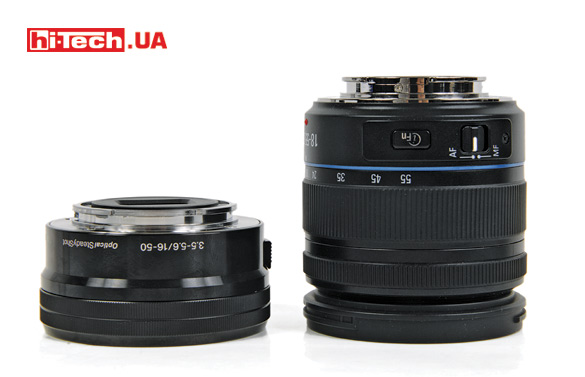
With similar focal lengths and aperture ratios, the sizes of standard lenses differ significantly (Samsung lens on the right)
I liked the external design of the Sony E PZ 16-50mm F3.5-5.6 OSS more, it feels more solid. Please also note that with comparable characteristics, this lens is noticeably more compact. One of the interesting features of the Sony E PZ 16-50mm F3.5-5.6 OSS can be noted that the lens changes in size when working and not working. Another interesting point: the lens drive is electronic. By rotating the zoom ring you are not moving the lenses directly. A command is sent to the lens controller and the motor already changes the focal length. During manual focusing, the same ring is used to focus. By the way, you can also use a special lever for zooming, and not just the ring. The Sansung 18-55mm F3.5-5.6 OIS III also has an interesting feature. By pressing a special button on the i-Function lens and rotating the second ring, you can change some shooting settings (aperture, ISO, exposure compensation, etc.).
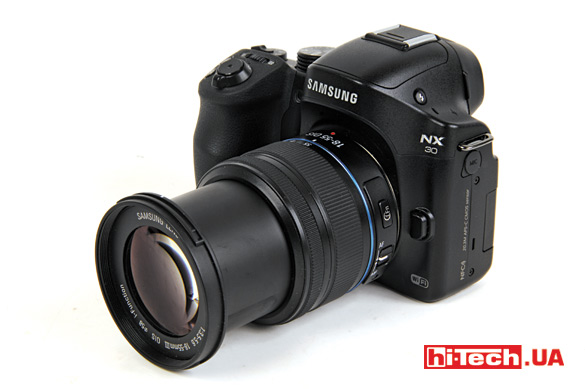
By pressing a special button on the i-Function lens and rotating the second ring, you can change some shooting settings (aperture, ISO, exposure compensation, etc.)
Both Samsung and Sony have been producing mirrorless cameras of this class for many years now, and in parallel with the release of cameras, more and more new lenses are being developed. In a separate table you can see the list of branded lenses compatible with the Samsung NX30 and Sony Alpha a6000. The choice may not be as large as for DSLR cameras, but there is definitely plenty to choose from.
Camera sensitivity was assessed using RAW files. They lack in-camera processing, including noise reduction, and allow you to evaluate the real noise level. Both cameras showed similar results when shooting at different sensitivities. Up to ISO 3200 inclusive, noise is slightly less on the Samsung NX30. At ISO values from 6400 I give preference to the Sony Alpha a6000. However, the difference is really small. In general, cameras are capable of providing very high image quality, and I would characterize their sensitivity as high.
Separately, I decided to look at the capabilities of standard lenses for macro shooting. The Samsung lens is capable of providing a slightly larger scale (see photo).
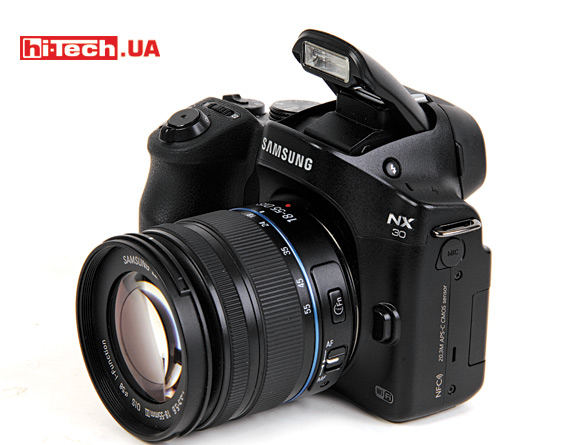
The cameras have built-in flashes, but I would recommend using them as little as possible. The devices have a good sensitivity reserve, and the flat light of the built-in flash clearly does not decorate the photo. Pictures taken using the built-in flash are only suitable for some kind of reporting, like, here we are sitting at the table
Video filming
Large matrices have a positive effect on the quality of not only photos, but also videos. True, there is a nuance. Most cameras do not use all the pixels of the matrix when shooting video, and the Samsung NX30 and Sony A6000 cameras are no exception in this regard. But even with such partial use of a large matrix, the video quality is often very cool. We are talking here about sensitivity and the ability to “play” with depth of field (DOF). Even professionals have recently often preferred photo cameras over video cameras for shooting video.
By the way, compared to SLR cameras, mirrorless cameras do not have the disadvantage associated with the operation of the autofocus system (more details in hi-Tech PRO July-Feb 2012, p. 74).
In short, both the Samsung NX30 and the Sony Alpha a6000 shoot video well. In both cameras, you can change the aperture, shutter speed, and sensitivity for video mode. For more serious work, the NX30 has a standard microphone jack. You can also connect an external microphone to the Sony Alpha a6000, but for this you will need to use the proprietary Multi Interface Shoe adapter.
When using standard lenses in the Samsung NX30, extraneous noise from the autofocus system is completely unnoticeable. There is some noise when zooming. The Sony Alpha a6000 had more extraneous noise during zooming.
In terms of autofocus speed and accuracy, I liked the Sony Alpha a6000 more. The Samsung NX30 comes in handy with its touchscreen display. Setting the focus point directly while shooting by touching the screen is very convenient.
Both cameras can shoot video in 1080p60 (p50) format – 1920×1080 resolution with progressive scanning and 60 fps. If necessary, both models allow you to switch between the European shooting speed format (25, 50 fps) and the American (30, 60 fps).
Using the links below you can download the original video files obtained during daytime and evening video shooting with Sony Alpha a6000 and Samsung NX30 cameras.
Functionality, Wi-Fi, Applications
Both amateurs and advanced users will find a lot of interesting things for themselves in cameras of this class. Beginners will love the numerous automatic modes, while enthusiasts will enjoy a wealth of different shooting options. These are semi-automatic and manual exposure adjustment modes (shutter speed, aperture priority, manual mode), bracketing, a large number of buttons with direct settings of certain parameters, and the ability to program some buttons to your taste.
It was a little unexpected that the presented cameras do not have a built-in RAW converter. You can’t say that there is an urgent need for such a function, but it wouldn’t hurt.

Smartphone screen as a camera viewfinder? Today this is no longer surprising. Below is a screenshot of the application when working with Samsung NX30, above – with Sony A6000
Both cameras have panorama shooting modes, and shooting with the HDR effect is available. It is curious that the functionality of the Sony Alpha a6000 camera can be expanded by installing additional applications, just as it happens on a smartphone. You need to connect to a Wi-Fi point with Internet access, and after entering your Sony Network Entertainment account information, a list of available applications appears in a special section. The problem is that many applications are paid, and there is no official support for the service in Ukraine. Among the paid applications there were also quite standard ones. For example, I needed to enable time-lapse photography for a battery test, and this feature, as it turned out, is not initially available on the Sony Alpha a6000, but appears after installing a paid application.
Wi-Fi can also be used to upload photos to the Internet or to a smartphone. The smartphone can also be used as a wireless camera remote control with image display on the screen of a mobile device.
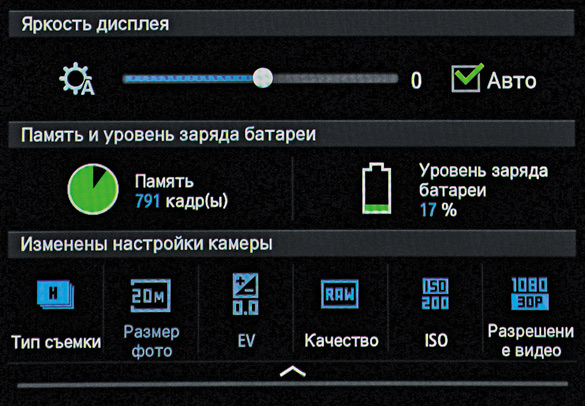
Just like in smartphones, if you drag your finger across the screen of the Samsung NX30, you can bring up an information window with the current settings
Samsung NX30 provides similar Wi-Fi functionality. It also works with a smartphone; photos can be sent to the cloud. The curious Baby Monitor mode is also supported. The camera can be left in the child’s room, and when he cries or makes loud noises, a notification will be sent to the smartphone. At the same time, you can turn on the camera and remotely see what is happening there on the smartphone screen. If the room is dark, you can even turn on the backlight on the camera.

A child screamed in the bedroom – a notification arrived on your smartphone (Baby Monitor application for working with the Samsung NX30 camera)
Difficult choice
Samsung NX30 and Sony Alpha a6000 proved to be very worthy opponents. By choosing any of these models, you will get a cool, modern, functional camera with good photo and video quality. The Sony is more compact, but the Samsung has a more advanced rotating screen with touch controls. Based on many key parameters, first of all, the quality of shooting is difficult to choose a winner, but personally, my sympathy is more on the side of the Sony Alpha a6000. The scales were tipped by its more productive burst mode and the subjectively more advanced autofocus system.
Engineer of the Test Laboratory
Don't miss interesting news
Subscribe to our channels and read announcements of high-tech news, tes
Oppo A6 Pro smartphone review: ambitious

Creating new mid-range smartphones is no easy task. Manufacturers have to balance performance, camera capabilities, displays, and the overall cost impact of each component. How the new Oppo A6 Pro balances these factors is discussed in our review.
Editor’s Choice 2025. Best devices of the year by hi-tech.ua
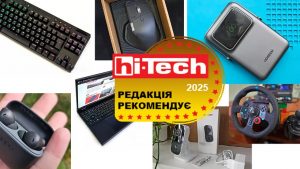
The best gaming laptops, mice for work, gaming keyboards, smartphones, and wireless headphones of 2025. Among them, we will highlight the most interesting ones and those that we can recommend buying.
Modern Mercedes-Benz Unimog get 7.7-liter V6 car Mercedes-Benz
The concept is based on the Mercedes-Benz Unimog U 4023 with portal axles, a robust frame and a full set of differential locks. The main technical change was the replacement of the standard 5.1-liter diesel engine
Honor почне випускати ігрові смартфони games Honor smartphone
За швидкодію відповідають флагманські платформи Qualcomm: Honor Win побудований на Snapdragon 8 Elite, а Honor Win Pro – на новітньому Snapdragon 8 Elite Gen 5


